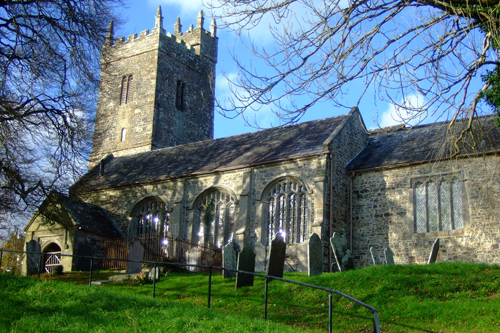Reportedly to be the second largest in Devon, Broadwoodwidger is made up of many Hamlets developed originally from the need to house the workers on the larger farms of the area. The Parish is roughly pear shaped, the distance around the boundary being twenty three miles, the length five and a half miles, the widest part across is four and a half miles and the narrowest part one and a half miles. In 1967 it is recorded that “the acreage of the Parish to be 10,655 acres.”
From 1894 to 1966 the Parish was a rural district in the administrative county of Devon. The rural district comprised of six civil parishes: Broadwoodwidger, Northcott, North Petherwin, St Giles on the Heath, Virginstow and Werrington. Part of the rural district lay west of the River Tamer, forming a salient surrounded by Cornwall on three sides. The county boundary was realigned when the district was abolished in 1966 and Broadwoodwidger passed to Holsworthy Rural District.
Broadwoodwidger village stands on a steep hill above the wooded valley of the river Wolf, with splendid views of Dartmoor from the Churchyard.
In the nineteenth century a pub, post office, blacksmith, tailors shop and carpenter’s shop all thrived, but by the end of the twentieth century, with the closure of the post office, all were gone.
Through modern excavations in the Parish, with the building of Roadford Reservoir, Archaeologists from Exeter Museum recorded the historic farmsteads and hamlets dating back to the middle Ages. This helped to piece together the story of the valley’s environment going back some 5000 years to prehistoric times. Traces of prehistoric activity stretching back as early as 2550 BC were discovered.
In 1987 – 88 excavation of the “lost” village of Hennard Mill took place, this medieval settlement, originally part of the Doomsday Manor of Southweek, had only a single cottage still standing in 1987. Excavation revealed the well-preserved remains of as many as nine buildings including two mills. One mill was a grist mill whilst the other was used for fulling cloth, one of Devon’s great historic industries. The cottages at Hennard Mill were very small buildings with cobbled floors and cob walls. One was a longhouse with space for the farmer’s family and his livestock under the same roof. The cottages were grouped around an open “town place” or village green.
Compiled by A. Worden (2012)



